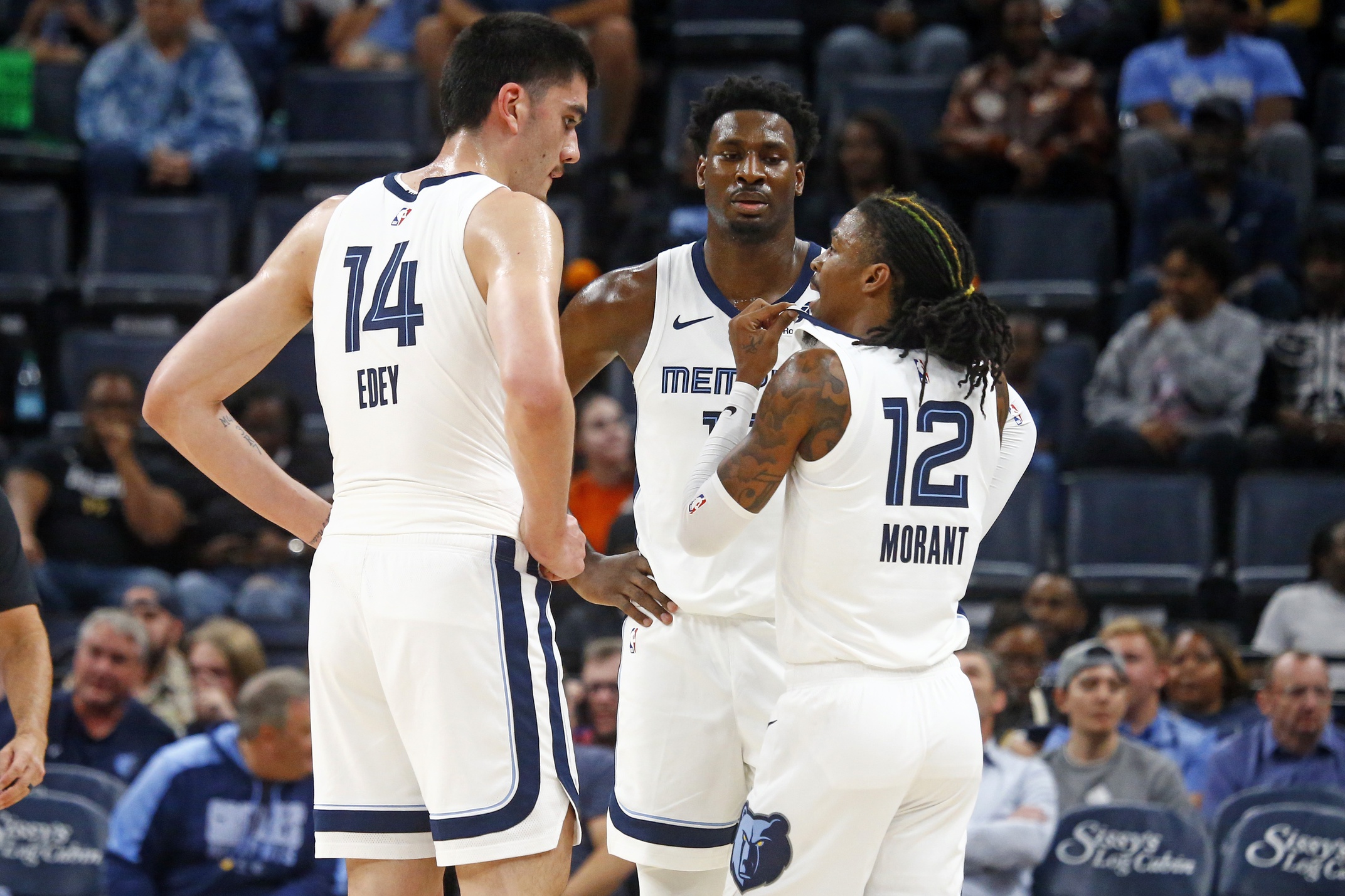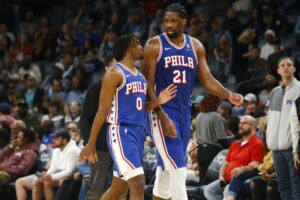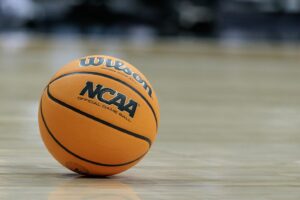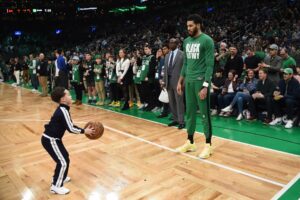With just 14 games under their belt, the battle-tested and equipped Memphis Grizzlies have been challenged with various hurdles that could have shaped their season in one way or another. The Grizzlies are currently 8-6, good for seventh in the Western Conference. With heightened expectations, keeping a close eye on this roster has been nothing short of a thrill thus far.
Grizzlies GM Zach Kleiman continues to demonstrate his sharp eye for unique talent. Head Coach Taylor Jenkins continues to lead a staff that maximizes its players’ potential and prioritizes development. With a roster loaded with promise and key contributors slowly returning to the hardwood, the Grizzlies will evolve into a Western Conference powerhouse. Let’s explore the good and bad elements of the Grizzlies’ season so far.
The Good, the Bad, the Grizzly: A Memphis Grizzlies Regular Season Check-In
The Memphis Grizzlies are among only five teams (Boston Celtics, Golden State Warriors, Cleveland Cavaliers, Dallas Mavericks) to rank in the top 10 in the NBA in both offensive and defensive ratings through Nov 18th. The franchise’s most valuable possession, Ja Morant, has missed the Grizzlies’ last five games as he’s considered week to week with a right hip flexor injury. Co-backcourt mate Desmond Bane recently returned to the hardwood Friday after missing his previous seven games with an oblique injury. The Grizzlies also welcomed back multi-dimensional wing guards Marcus Smart and Vince Williams Jr. recently from lower extremity injuries. Versatile forwards Santi Aldama and Jake LaRavia have been valuable contributors this season as well. Their sixth-best NBA net rating simply reflects their next-man mentality and unity.
The Good
Jaren Jackson Jr. may not jump out of your television, but he’s been the Grizzlies’ best player this season. The Tom Izzo disciple is anchoring the NBA’s fifth-best defense and a unit that leads the league in blocks. Jackson Jr. is averaging 23.1 points per game on an exceedingly efficient 53 FG% (both career-highs) shooting from the floor. Jackson Jr. also leads the team in plus/minus. Out of the six most productive Grizzlies’ five-man units this season, Jackson Jr. is a part of three of those rotations.
Grizzly Young Guns Check-In
Guards Scotty Pippen Jr. and Jaylen Wells have filled in the depleted guard depth chart exceptionally this season. At least one of the young guards is a part of each of the Grizzlies’ six most productive units this season. They both have been excellent complements to the Grizzlies’ stars, impacting the game in a multitude of ways. The son of the Naismith Basketball Hall of Famer has been quarterbacking the Grizzlies’ offense proficiently during non-Morant minutes, and games Morant has missed as a whole. Among all players who are averaging at least 25 minutes a game and have made at least 10 appearances this season, Pippen Jr. has a superior assist-to-turnover ratio than LeBron James, Shai Gilgeous-Alexander, and Trae Young.
Wells has fulfilled the off-guard role that’s usually optimized by Bane. His shooting prowess and activity as a complementary playmaker and defender have elevated the Grizzlies’ secondary units. Wells is shooting just a tick under 37% from the three-point line on 4.6 attempts a night. More shared playing time with a proven prolific shooter in Bane only means there are optimistic heights for this Grizzlies’ offense to reach. Rookie big man Zach Edey has also been a revelation for the Grizzlies. Edey’s presence has alleviated Jaren Jackson Jr. from being the sole brute force on the backline of the Grizzlies’ defense. The Grizzlies boast a 94.3 defensive rating when Jackson Jr. and Edey share the floor.
Ja’s Play
The only deficiency that’s been glaring during the early stages of the Grizzlies’ season has been Morant’s inefficient scoring and aggression. Morant is averaging just 20.6 points per game, shooting a shade under 45% from the field. His field goal percentage is on pace to be a career low, while his ppg is the lowest since his second season.
Morant is averaging five fewer FGA/game compared to his first All-Star campaign in 2021-22. In contrast, Morant is posting a career-high in assists per game. Morant to this point, has made it a motive to trade in his volume daredevil drives toward the rack for a more laid-back floor general approach. Those dividends will pay off on that end as it’ll preserve his nuclear athletic ability. But does it automatically make the Grizzlies a better unit as a whole? Does Morant strike the same fear in his opponents doing so?
Morant’s Shooting
Morant is one of the game’s most lethal dual-threat point guards. One facet of his game that he’s yet to master is his intermediate game. This season, Morant is shooting a dreadful 21.1% on pull-up jump shots. Overall, Morant is shooting 25% from deep this season. His patented push floater in the lane is a go-to move of his. The addition of Edey was expected to open up additional looks in the elbow/paint area for Morant it’s yet to come to fruition. In the playoffs, opponents will have more time to game-plan for your weaknesses and deficiencies.
With the help of Edey and Jackson Jr. on set pick and rolls, Morant can demand the respect of defenses on his pull-up jumper. If he can evolve into an above-average-level jump-shooter, the Grizzlies can challenge anyone in the Western Conference. Some may naively point to his lengthy absences the past couple of seasons as reasons why he hasn’t been quite the same demoralizing scorer in the half-court.
How Morant is Still Impactful
Other observers of Morant’s approach this season would offer that this is perhaps the deepest roster he’s ever been a part of. As the franchise point guard, Morant is obligated to solve the puzzle and make this team a well-oiled machine to the best of his abilities. His gracious efforts and sacrifice have been evident.
The Grizzly
This portion of the Memphis Grizzlies check-in was most likely interpreted as “the ugly” upon first reading. However, I’d like to describe this portion rather as the biggest variable that can impact their season. Health. I can’t re-iterate how vital health is for this group from here on out. As of right now, ten Grizzlies are averaging at least 20 minutes played per game. Re-shuffling the deck with now a majority healthy group will enhance the teams’ chemistry and camaraderie, a deck that may be very well suited to challenge any team in the league on any given night.






